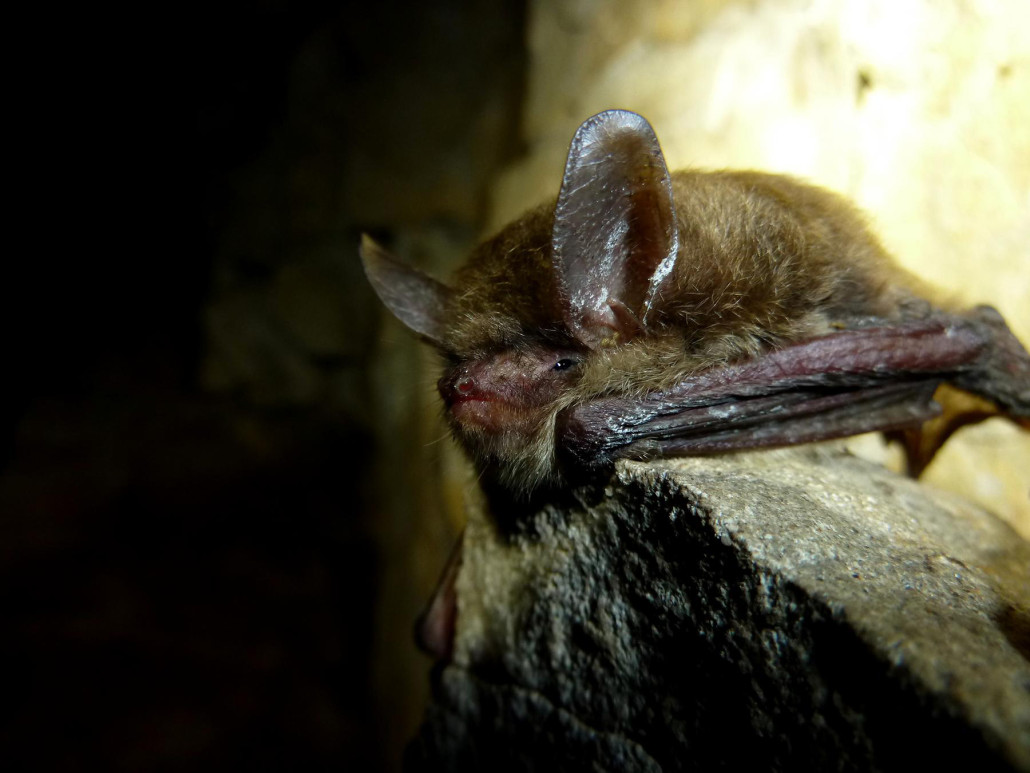
Northern Long-eared bat
Northern Long-eared Bat
Northern Long-eared Bat (Myotis septentrionalis septentrionalis)
(804) 729-0046 or toll-free at (888) 824-7383
Bat Removal in Virginia. Bats in Attic. Bat in House. Virginia Bats
Characteristics
The Northern Long-eared Bat is a medium-sized Myotis, with non-glossy brown fur with the stomach being lighter colored than the back. It has a long tail, and long ears (4-5 mm past muzzle end when forward). The adult total length is from 79-100 mm, with a wingspread of 228-258 mm. The weight 1/8 to 3/8 ounces (5-10 grams). Little is known about reproduction in this species but it is thought to follow the pattern of other myotis with mating in fall and the birth of one young in June-July. The females segregate into mating colonies of up to 30 or so individuals under tree bark, shingles, etc. . This species is more solitary than M. lucifugus and hibernates singly or in clusters of 4-6 in colonies of up to 350 individuals. Hibernation may begin as early as August, and this species prefers cool, moist sites (caves) with still air, often near the entrances but in areas where humidity is so high water droplets may cover their fur. In the summer they use less insulative shelters, and day and night roosts may differ (caves at night). They begin foraging just after dusk, with more foraging prior to dawn. This species is native. The longevity record is 18.5 years.
Distribution
The Northern Long-eared Bat species inhabits forested regions, and will forage mainly on hillsides, and ridge forests rather than riparian and flood-plain forests. They frequent areas under the forest canopy just above shrub level. It is unknown in hardwood forests in general.
Foods
The Northern Long-eared Bat forages on hillsides and ridges under the tree canopy feeding on small insects especially flies.
For fast, safe and humane Virginia Bat Removal contact us at (804) 729-0046 or toll-free at (888) 824-7383. Call us for more questions on Virginia’s Northern Long-eared bat.
Our Service Areas Include:
Afton, Albemarle County, Alexandria, Amelia County, Annandale, Arlington, Ashburn, Ashland, Barboursville, Bellwood, Belmont, Bensley, Bermuda Hundred, Bon Air, Boyd Tavern, Brandermill, Bumpass, Burke, Central VA, Centreville, Chamberlain, Charlottesville, Chesapeake, Chester, Chesterfield County, Colonial Heights, Crozet, Cuckoo, CVille, Dale City, Doswell, Dumbarton, Earlysville, East Highland Park, Enon, Ettrick, Fairfax, Fair Oaks, Ferncliff, Fluvanna County, Fredericksburg, Genito, Glen Allen, Glenora, Goochland County, Gordonsville, Gum Spring, Hadensville, Hampton, Hampton Park, Hanover County, Harrisonburg, Harrogate, Hening, Henrico County, Highland Springs, Hopewell, Innsbrook, Jefferson Davis, Kents Store, Keswick, Lake Anna, Lake Monticello, Lake Ridge, Lakeside, Laurel, Leesburg, Lewiston, Lignum, Locust Grove, Louisa County, Maidens, Manakin, Manakin-Sabot, Manassas, Manchester, McLean, Montrose, Motoaca, Meadowbrook, Mechanicsville, Midlothian, Mineral, Moseley, Newport News, Norfolk, North Courthouse, North Garden, Oilville, Orange County, Palmyra, Pantops, Petersburg, Portsmouth, Powhatan County, Reams, Reston, Richmond, Richmond County, Robious, Rockville, Rockwood, RVA, Salisbury, Sandston, Sandy Hook, Scottsville, Shannon Hill, Short Pump, South Rockwood, Spring Run, Staunton, Stoney Point, Suffolk, Tidewater, Troy, Tuckahoe, Va, Varina, Virginia, Virginia Beach, Waynesboro, Williamsburg, Winchester, Winterpock, Woodlake, Wyndham, and the surrounding areas of Virginia.
We also trap, remove, capture, control, manage and exclude all Virginia Wildlife and Animal Pest Control.
Please Complete Our Simple Contact Form Below:
Go to the full page to view and submit the form.
